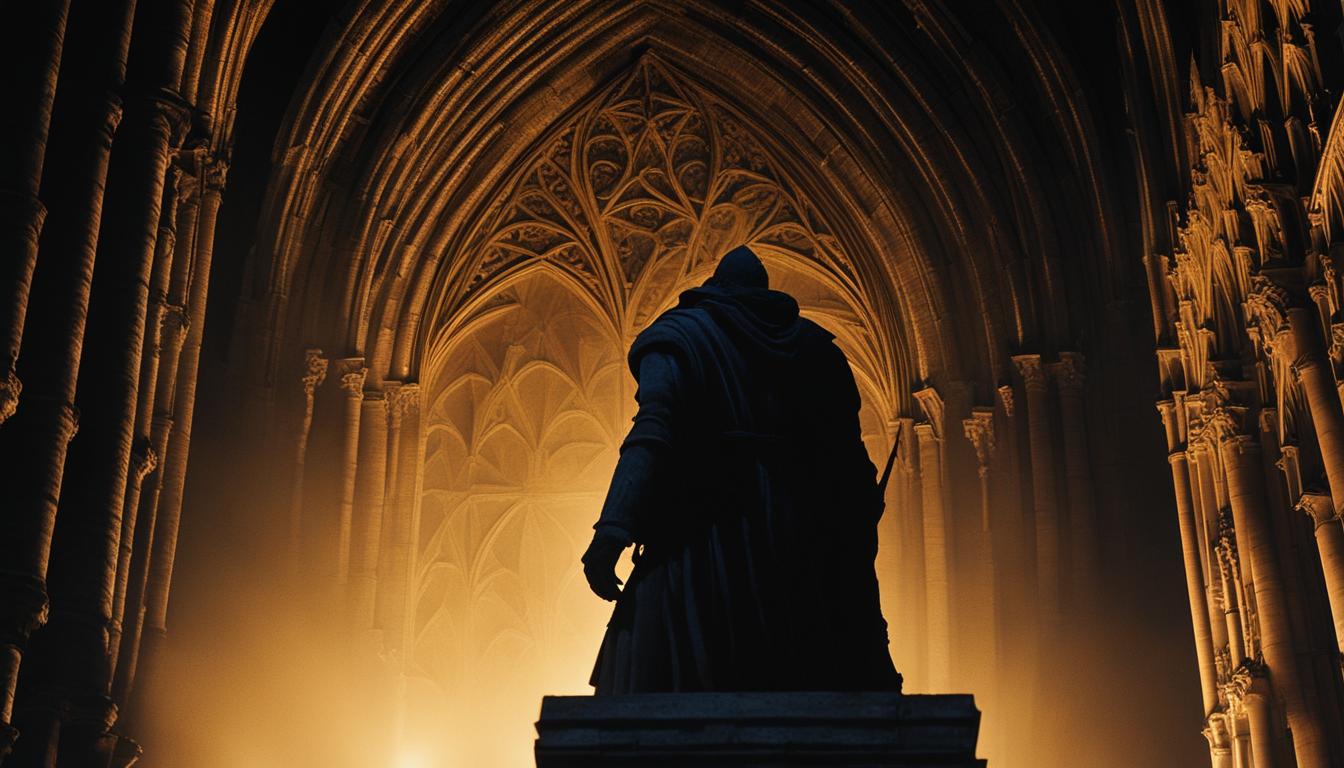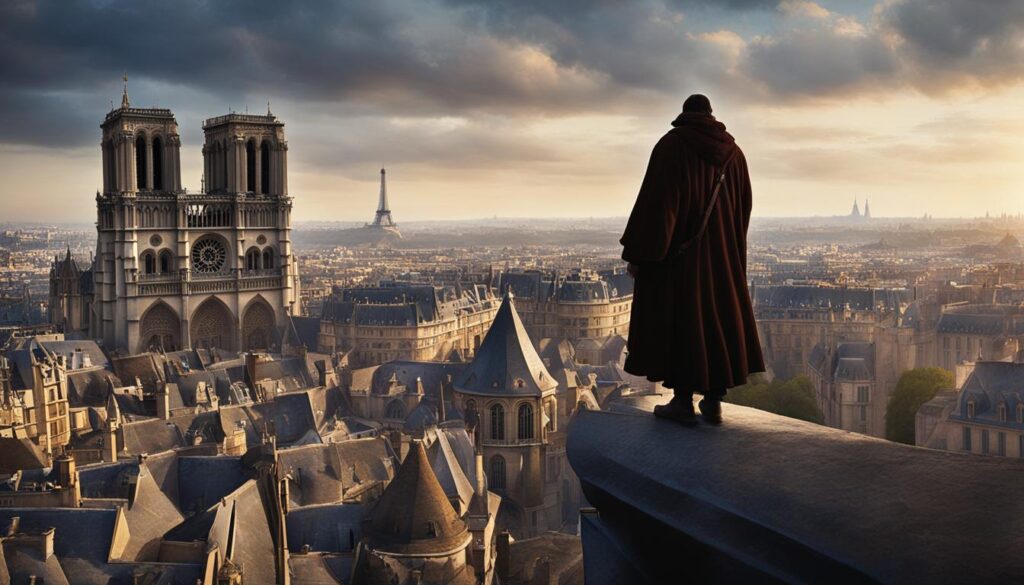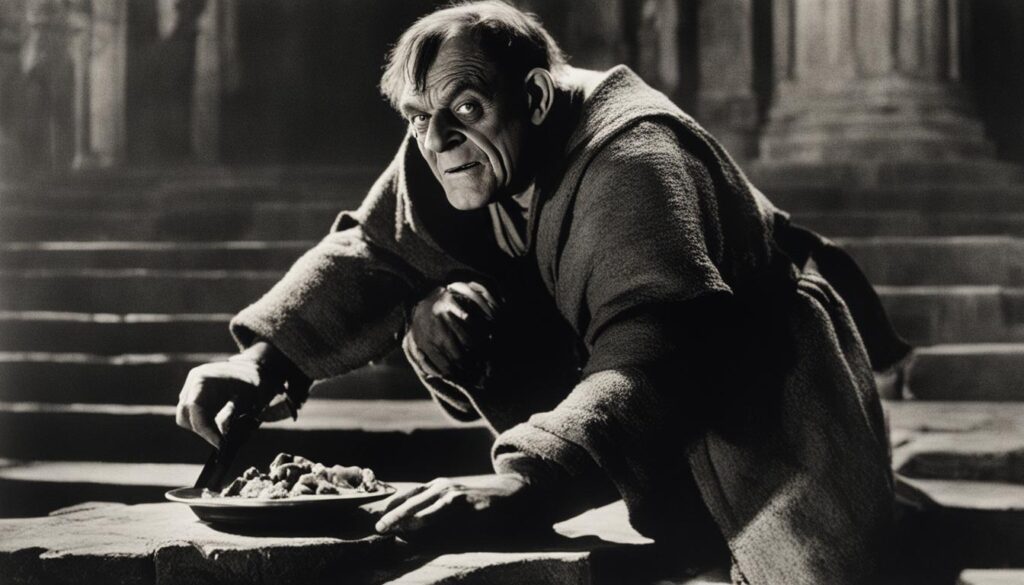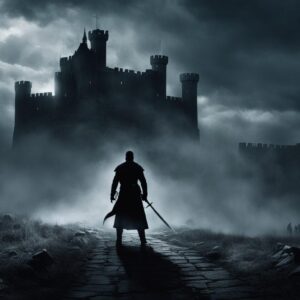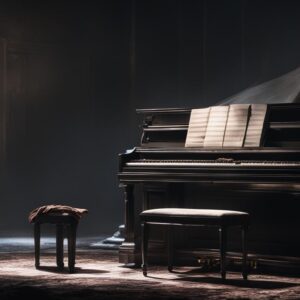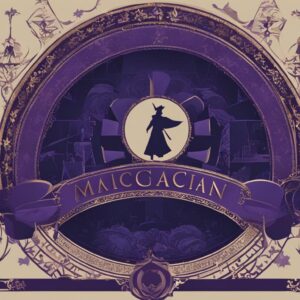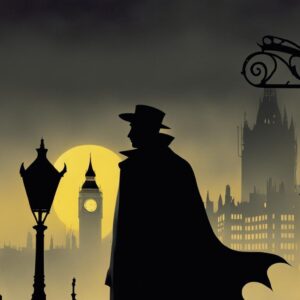Welcome to my article on the timeless classic, The Hunchback of Notre Dame (1923). This silent film adaptation of Victor Hugo’s Gothic novel has captivated audiences for decades with its stunning visuals, emotional storytelling, and unforgettable characters. Set in the heart of Paris, this cinematic masterpiece combines elements of horror drama and historical romance, bringing to life the tragic story of Quasimodo, a hunchbacked bell-ringer who falls in love with the beautiful gypsy, Esmeralda.
The Hunchback of Notre Dame (1923) is a true testament to classic cinema, showcasing the power of storytelling and the art of filmmaking. Its portrayal of Quasimodo’s journey, the intricate set design, and Lon Chaney’s iconic makeup transformation have solidified its place in film history. This article will delve into the making of the film, its cultural impact, and the enduring legacy it has left on cinema.
Key Takeaways:
- The Hunchback of Notre Dame (1923) is a silent film adaptation of Victor Hugo’s Gothic novel set in Paris.
- This classic cinema masterpiece combines elements of horror drama and historical romance.
- The film’s production details, including Lon Chaney’s iconic makeup, contribute to its visual appeal.
- The story explores themes of love, loneliness, and societal prejudice.
- The Hunchback of Notre Dame (1923) has had a lasting impact on cinema and inspired numerous adaptations.
The Making of The Hunchback of Notre Dame (1923)
The Hunchback of Notre Dame (1923) is a cinematic masterpiece that showcases the meticulous attention to detail in its production. Produced by Universal Pictures, the film starred Lon Chaney in the iconic role of Quasimodo, the hunchbacked bell-ringer. Lon Chaney’s transformation into Quasimodo was a testament to the art of makeup. It took three hours to apply the intricate prosthetics, including a false eye, false teeth, and a plaster hump.
The film’s production was equally massive. The set spanned an impressive nineteen acres, capturing the grandeur of Notre Dame and the surrounding Parisian landscape. Over two thousand extras were meticulously dressed in period clothing, adding authenticity to the film’s historical setting. The set design and costumes were meticulously crafted to transport viewers back to the 15th century Paris.
To fully appreciate the scale of the production, it’s important to note that The Hunchback of Notre Dame (1923) was made during the era of silent films, when technology and special effects were limited. The dedication to detail in both the makeup and set design is a testament to the commitment of the filmmakers to bring Victor Hugo’s Gothic novel to life on the silver screen.
| Production Details | Information |
|---|---|
| Production Company | Universal Pictures |
| Lead Actor | Lon Chaney |
| Makeup | Takes three hours to apply |
| Set Design | Spans nineteen acres |
| Extras | Over two thousand dressed in period clothing |
Through the combination of Lon Chaney’s transformative makeup and the elaborate set design, The Hunchback of Notre Dame (1923) remains a visually stunning film that has stood the test of time.
The Making of The Hunchback of Notre Dame (1923)
The Story of The Hunchback of Notre Dame (1923)
The Hunchback of Notre Dame (1923) begins with the vibrant and chaotic Festival of Fools in Paris. This day of revelry and liberation from the rule of King Louis XI sets the stage for the unfolding story. In the midst of the festivities, we are introduced to Quasimodo, a hunchbacked bell-ringer of Notre Dame Cathedral. Deaf and half-blind, he openly mocks the crowd, finding solace in his solitary observations.
It is during the festival that Quasimodo’s path crosses with that of Esmeralda, a captivating gypsy dancer. However, Quasimodo is not the only one drawn to her allure. Jehan, the wicked brother of Notre Dame’s archdeacon, and Phoebus de Chateaupers, the newly-appointed Captain of the Guard, also find themselves captivated by the beauty of Esmeralda.
As the film progresses, the complex dynamic of Parisian society emerges. The story delves into themes of love, betrayal, and societal prejudice. Quasimodo’s unrequited love for Esmeralda is tangled amidst the conflicting desires and motivations of the other characters. The intricate relationships and the exploration of Parisian society form the core of the film’s narrative, adding depth and complexity to this timeless classic.
Festival of Fools: A Symbolic Celebration
The Festival of Fools, portrayed in The Hunchback of Notre Dame (1923), serves as a symbolic celebration of both liberation and oppression. Through this event, the film highlights the contrasts and tensions that exist within society, illuminating the themes of love, prejudice, and the struggle for acceptance.
This lively festival becomes a backdrop against which the characters’ true natures are revealed. While Quasimodo freely embraces his unique and unapologetic self, the Festival of Fools also exposes the cruelty and hypocrisy of Parisian society. It becomes a stage for both revelry and tragedy, a microcosm of the world in which these characters inhabit.
Quasimodo’s deafening laughter and open mockery at the festival reflect his outsider status. His physical deformity has made him an object of scorn and ridicule, but it is in this celebration that he finds a temporary respite from the isolation that plagues him. The Festival of Fools becomes a poignant symbol of the contrasts and conflicts that shape the story of The Hunchback of Notre Dame (1923).
Love, Loneliness, and Class Warfare
The Hunchback of Notre Dame (1923) delves into the complex themes of love, loneliness, and class warfare. At its core, the film explores the pain of unrequited love through the character of Quasimodo. His deep affection for Esmeralda, the beautiful gypsy dancer, highlights the agony of desire that can never be fulfilled. This theme of unattainable love adds a layer of emotional depth to the narrative, drawing viewers into Quasimodo’s world of longing and heartbreak.
Furthermore, The Hunchback of Notre Dame (1923) delves into societal prejudice and the stark class divide that existed in Parisian society. The film portrays the Festival of Fools as a temporary release from the oppression of King Louis XI, but it also highlights the tensions and conflicts between different social classes. Through the interactions of characters such as Jehan, the wicked brother of Notre Dame’s archdeacon, and Phoebus de Chateaupers, the newly-appointed Captain of the Guard, the film explores the deep-rooted prejudices that often accompany societal hierarchies.
Quasimodo’s unrequited love for Esmeralda highlights the pain of unattainable desire, while the film also delves into the societal prejudice faced by those who are different.
The Hunchback of Notre Dame (1923) portrays the class warfare of Parisian society through the Festival of Fools, where the common man and the aristocracy collide. The stark contrasts between the revelry of the common folk and the cold detachment of the upper class underscore the deep divide and animosity between the two. This exploration of class warfare adds a layer of social commentary to the film, reflecting the societal issues of the time and resonating with audiences today.
In summary, The Hunchback of Notre Dame (1923) delves into the universal themes of love, loneliness, and class warfare. Through the lens of Quasimodo’s unrequited love, the film explores the pain of desire that can never be fulfilled. The portrayal of societal prejudice and the class divide in Parisian society provides a backdrop for the tensions and conflicts that arise throughout the narrative. These themes add depth and complexity to the film, making it a thought-provoking exploration of the human condition.
A Platinum-Tier Production
The Hunchback of Notre Dame (1923) proved to be a remarkable success for Universal Pictures, solidifying its status as a “Super Jewel” in the studio’s roster. The film’s box office triumph was unparalleled, grossing $1.5 million domestically and a staggering $3.5 million globally. Audiences flocked to theaters to witness Lon Chaney’s transformative performance as Quasimodo and to experience the visually stunning adaptation of Victor Hugo’s Gothic novel. The success of The Hunchback of Notre Dame (1923) catapulted it into the realm of platinum-tier productions, becoming a benchmark for future films in terms of quality and craftsmanship.
The undeniable influence of Lon Chaney’s makeup in The Hunchback of Notre Dame (1923) cannot be understated. Chaney’s meticulous and time-consuming application of prosthetics, including a false eye, false teeth, and a plaster hump, brought Quasimodo to life in a way that captivated audiences. His haunting portrayal of the hunchbacked bell-ringer established Chaney as a master of makeup and laid the foundation for future films to explore the transformative potential of prosthetics and special effects. The iconic and unforgettable image of Quasimodo continues to resonate with audiences, showcasing the lasting impact of the film.
Furthermore, The Hunchback of Notre Dame (1923) influenced the course of cinematic history with its groundbreaking production techniques. The film’s massive set, spanning nineteen acres, and the inclusion of over two thousand extras in period clothing showcased the dedication to detail and the ambition of the production team. The scale and scope of the film set a new standard for cinematic storytelling and inspired future filmmakers to push the boundaries of what could be achieved on the silver screen. The Hunchback of Notre Dame (1923) remains an enduring testament to the power of innovative filmmaking and the ability to create a truly immersive cinematic experience.
The Hunchback of Notre Dame (1923): A Box Office Triumph
| Film | Domestic Gross | Global Gross |
|---|---|---|
| The Hunchback of Notre Dame (1923) | $1.5 million | $3.5 million |
“The success of The Hunchback of Notre Dame (1923) propelled it into the annals of cinematic history, establishing it as a platinum-tier production that set a new standard for visual storytelling.”
The Hunchback of Notre Dame (1923) was not only a box office success and a groundbreaking production but also left an indelible mark on the future of filmmaking. It showcased the transformative potential of makeup and special effects, influencing subsequent films in their portrayal of iconic characters and their commitment to visual storytelling. The film’s enduring legacy is a testament to its lasting impact and its status as a cinematic masterpiece that continues to captivate audiences to this day.
Reception and Legacy
The Hunchback of Notre Dame (1923) received critical acclaim upon its release and has since left a lasting impact on the world of cinema. The film’s stunning visuals, emotional storytelling, and standout performances garnered praise from audiences and critics alike. Its depiction of Quasimodo’s struggles and the complex dynamics of Parisian society resonated with viewers, solidifying its status as a timeless classic.
Over the years, The Hunchback of Notre Dame (1923) has continued to be celebrated for its cultural significance. The film’s enduring legacy can be seen in the numerous adaptations and references in popular culture. From Disney’s animated film to stage musicals and live-action adaptations, the story has captivated audiences across different mediums.
“The Hunchback of Notre Dame (1923) is a cinematic masterpiece that has left an indelible mark on the history of film. Its themes of love, acceptance, and societal prejudice continue to resonate with audiences, making it a timeless classic.” – Film critic
The film’s cultural impact has also led to preservation efforts to ensure its long-term accessibility. Restorations and screenings at film festivals have kept The Hunchback of Notre Dame (1923) alive, allowing new generations to experience its beauty and significance.
| Key Points | Details |
|---|---|
| Critical Acclaim | The film received praise for its stunning visuals, emotional storytelling, and standout performances. |
| Lasting Impact | The Hunchback of Notre Dame (1923) has inspired numerous adaptations and references in popular culture. |
| Preservation Efforts | The film has undergone restorations and continues to be screened at film festivals to ensure its accessibility for future generations. |
The Hunchback in Modern Cinema
Over the years, the timeless classic, The Hunchback of Notre Dame (1923), has inspired numerous adaptations in modern cinema, showcasing its enduring appeal and cultural significance. One of the most notable adaptations is Disney’s 1996 animated film, which introduced the story to a new generation of viewers. Bringing the beloved characters of Quasimodo and Esmeralda to life through vibrant animation and memorable musical numbers, the Disney adaptation captured the hearts of audiences worldwide.
In addition to the animated film, The Hunchback of Notre Dame (1923) has also seen several live-action adaptations. A notable example is the 1997 television film, which offered a fresh interpretation of the story. More recently, a 2021 Netflix series brought a new twist to the narrative, showcasing the enduring popularity of the characters and themes explored in the original silent film.
The timeless tale of The Hunchback of Notre Dame (1923) has also been adapted into stage musicals, further demonstrating its impact on the world of performing arts. These musical adaptations bring the story to life through captivating music, elaborate stage designs, and powerful performances. The enduring appeal of the characters and the themes explored in the original film continue to resonate with audiences, making The Hunchback of Notre Dame a beloved and influential story in modern cinema.
Table: Comparison of The Hunchback Adaptations in Modern Cinema
| Adaptation | Year | Medium |
|---|---|---|
| Disney’s The Hunchback of Notre Dame | 1996 | Animated Film |
| The Hunchback of Notre Dame (1997) | 1997 | Television Film |
| The Hunchback of Notre Dame (2021) | 2021 | Netflix Series |
| Stage Musical Adaptations | Various | Theater |
The table above provides a comparison of The Hunchback of Notre Dame adaptations in modern cinema, showcasing the diverse ways in which the story has been reimagined across different mediums.
The Hunchback’s Cultural Impact
The character of Quasimodo from The Hunchback of Notre Dame (1923) has had a profound cultural impact, becoming an iconic figure in popular culture. His story, filled with themes of love and acceptance, has resonated with audiences and continues to inspire and challenge societal perceptions. Quasimodo’s representation of disability in the film has also been praised for its honest portrayal and contribution to diversity in film and literature.
Quasimodo’s enduring appeal lies in his status as a sympathetic antihero. Lon Chaney’s powerful portrayal of the character brought a depth and emotional complexity to Quasimodo, making him a relatable and beloved figure. The film’s exploration of themes such as societal prejudice and unrequited love further added to its cultural significance.
“Quasimodo’s struggles and triumphs as a disabled character have resonated with audiences, highlighting the importance of diverse representation in film and literature.” – Film Critic
Table: Quasimodo’s Cultural Impact
| Aspect | Impact |
|---|---|
| Iconic Character | Quasimodo has become an enduring and recognized figure in popular culture. |
| Themes of Love and Acceptance | The film’s exploration of these themes has resonated with audiences and continues to inspire. |
| Representation of Disability | Quasimodo’s portrayal as a disabled character has been praised for its authenticity and contribution to diverse representation. |
The impact of Quasimodo and The Hunchback of Notre Dame (1923) extends beyond the film itself. The character’s enduring popularity has led to numerous adaptations in modern cinema, stage musicals, and references in popular culture, further solidifying his status as an iconic figure. Quasimodo’s story serves as a reminder of the power of love, acceptance, and the strength of the human spirit, making him a timeless character.
The Hunchback of Notre Dame (1923) and French Literature
The Hunchback of Notre Dame (1923) is a cinematic adaptation of Victor Hugo’s Gothic novel, showcasing the enduring power of Hugo’s storytelling and paying homage to the rich literary tradition of French literature. Hugo’s novel, originally published in 1831, delves into themes of social injustice and the human condition, exploring the complexities of love, prejudice, and redemption.
With its stunning visuals and emotional storytelling, the film captures the essence of Hugo’s work, bringing to life the vivid characters and intricate plotlines. The Hunchback of Notre Dame (1923) serves as an introduction to Hugo’s themes and characters for a new generation, fostering a continued appreciation for his literary contributions.
“Literature is an immense sandbank before which all human science is dry sand.” – Victor Hugo
The Hunchback of Notre Dame (1923) stands as a testament to the lasting influence of French literature. By adapting Hugo’s masterpiece into a film, it solidifies the connection between cinema and literature, highlighting the impact that written works can have on visual storytelling. The adaptation also serves as an invitation for audiences to explore Hugo’s original novel and discover the depth and complexity of his literary genius.
| Table: Influences of The Hunchback of Notre Dame (1923) |
|---|
| The film showcases the enduring power of Victor Hugo’s storytelling |
| Brings attention to the themes of social injustice and the human condition explored in the original novel |
| Introduces a new generation to the characters and themes of French literature |
| Highlights the connection between cinema and literature |
| Invites audiences to explore Victor Hugo’s original novel |
Quasimodo: A Timeless Character
Lon Chaney’s portrayal of Quasimodo in The Hunchback of Notre Dame (1923) is nothing short of exceptional. His performance as the sympathetic antihero brings a unique emotional depth to the character, making Quasimodo a timeless figure in film history. Chaney’s ability to convey Quasimodo’s struggles, resilience, and capacity for love is truly remarkable.
Through his physical transformation and hauntingly expressive eyes, Chaney captures the essence of Quasimodo’s tragic existence. The hunchbacked bell-ringer’s isolation and longing for acceptance are palpable, evoking empathy from audiences. Despite his outward appearance, Quasimodo’s inner beauty shines through, revealing his kind heart and unwavering loyalty.
“Chaney’s performance as Quasimodo is a masterclass in portraying complex characters. His ability to convey Quasimodo’s range of emotions, from heartbreak to rage to profound love, is a testament to his incredible talent.”—Film critic
Quasimodo’s timeless character continues to resonate with audiences, serving as a powerful reminder of the universal human experiences of love, acceptance, and the struggle for belonging. Lon Chaney’s portrayal has left an indelible mark on cinema history, solidifying his status as one of the greatest actors of the silent era.
The Message of The Hunchback of Notre Dame (1923)
The Hunchback of Notre Dame (1923) delivers a powerful message of love and acceptance. This timeless classic serves as a social commentary, urging viewers to look beyond appearances and embrace diversity. The film reminds us that true beauty lies within and that kindness and understanding can transcend societal barriers. In a world filled with prejudice and discrimination, The Hunchback of Notre Dame (1923) encourages us to practice human compassion and strive for a more inclusive society.
In the story, Quasimodo, a hunchbacked bell-ringer, faces rejection and mistreatment because of his physical appearance. However, he possesses a kind and gentle heart that yearns for love and acceptance. Through Quasimodo’s journey, the film challenges societal norms and prejudices, highlighting the importance of empathy and understanding.
“The world is cruel, and the only morality in a cruel world is chance.” – Quasimodo
The Hunchback of Notre Dame (1923) serves as a timeless reminder that love and compassion can conquer hate and prejudice. It calls for a society where individuals are valued for their character and kindness, rather than their physical attributes. The film’s enduring message has resonated with audiences for nearly a century, making it an essential piece of cinema that continues to inspire and provoke thought.
| Themes | Description |
|---|---|
| Love and Acceptance | The film explores the power of love and the importance of accepting others for who they are. |
| Social Commentary | The Hunchback of Notre Dame (1923) critiques societal prejudices and challenges the status quo. |
| Human Compassion | Through the character of Quasimodo, the film emphasizes the significance of empathy and understanding towards one another. |
The Soundtrack of The Hunchback of Notre Dame (1923)
The Hunchback of Notre Dame (1923) is not only renowned for its stunning visuals and powerful performances but also for its hauntingly beautiful soundtrack composed by Carl Davis. The emotional impact of the film is further enhanced by the atmospheric music, which adds depth and resonance to the storytelling.
The soundtrack of The Hunchback of Notre Dame (1923) captures the essence of the film’s themes, including love, loneliness, and societal prejudice. Through its evocative melodies and sweeping orchestral arrangements, the music heightens the audience’s emotional connection to the characters and their struggles. It paints an auditory landscape that transports viewers into the heart of the story, immersing them in the world of Quasimodo and the bustling streets of Paris.
Carl Davis’ score for The Hunchback of Notre Dame (1923) is a testament to the power of music in cinema. It not only enhances the dramatic moments of the film but also underscores the quieter, introspective scenes, allowing the audience to delve deeper into the inner turmoil of the characters. The music becomes a character in itself, evoking a range of emotions and creating an unforgettable cinematic experience.
The hauntingly beautiful score of The Hunchback of Notre Dame (1923) is a testament to the artistry and craftsmanship that went into creating this timeless classic. It is a perfect complement to the mesmerizing visuals and powerful performances, further immersing viewers in the rich tapestry of the film. The soundtrack of The Hunchback of Notre Dame (1923) stands as a testament to the enduring power of music in cinema, adding an extra layer of emotional depth to an already captivating story.
| Key Features of The Hunchback of Notre Dame (1923) Soundtrack | Examples |
|---|---|
| Emotional melodies | -“Love Theme” |
| Orchestral arrangements | -“Quasimodo’s Theme” |
| Atmospheric music | -“City of Paris” |
| Powerful crescendos | -“Final Battle” |
| Quiet, introspective moments | -“Solitude” |
Conclusion
The Hunchback of Notre Dame (1923) is truly a timeless classic that has left an indelible mark on the world of cinema. The film’s compelling story, stunning visuals, and powerful performances make it a masterpiece that continues to captivate audiences today.
One of the key reasons for the enduring appeal of The Hunchback of Notre Dame (1923) is Lon Chaney’s unforgettable portrayal of Quasimodo. His performance as the hunchbacked bell-ringer showcases his incredible talent and brings a depth and complexity to the character that resonates with viewers.
The production of The Hunchback of Notre Dame (1923) by Universal Pictures is also worth mentioning. The attention to detail in both the makeup and set design contributes to the film’s visual splendor. The film’s success at the box office and its lasting influence on future films further solidify its status as a cinematic masterpiece.
In conclusion, The Hunchback of Notre Dame (1923) is a must-watch film that combines elements of horror drama and historical romance. Its timeless themes of love, acceptance, and societal prejudice continue to resonate and inspire audiences. This cinematic gem, brought to life by Lon Chaney’s unforgettable performance and Universal Pictures’ remarkable production, is truly a testament to the power of storytelling.
FAQ
Is The Hunchback of Notre Dame (1923) a silent film?
Yes, The Hunchback of Notre Dame (1923) is a silent film adaptation of Victor Hugo’s Gothic novel.
Who starred in The Hunchback of Notre Dame (1923)?
The film starred Lon Chaney in the iconic role of Quasimodo.
How long did it take to apply Lon Chaney’s makeup?
Lon Chaney’s makeup, which included a false eye, false teeth, and a plaster hump, took three hours to apply.
How big was the set for The Hunchback of Notre Dame (1923)?
The set spanned nineteen acres and included over two thousand extras dressed in period clothing.
What is the story of The Hunchback of Notre Dame (1923)?
The film follows the tragic story of Quasimodo, a hunchbacked bell-ringer who falls in love with the beautiful gypsy, Esmeralda.
What themes are explored in The Hunchback of Notre Dame (1923)?
The film explores themes of love, loneliness, and class warfare.
How successful was The Hunchback of Notre Dame (1923) at the box office?
The film grossed $1.5 million domestically and $3.5 million globally, making it a box office success.
Has The Hunchback of Notre Dame (1923) received critical acclaim?
Yes, the film received critical acclaim upon its release and is considered a landmark film in the silent era.
Has The Hunchback of Notre Dame (1923) inspired any adaptations?
Yes, the story has been adapted into Disney’s animated film, live-action adaptations, and stage musicals.
What is the cultural impact of The Hunchback of Notre Dame (1923)?
The film has become a cultural icon, with its characters and themes resonating with audiences for decades.
How does The Hunchback of Notre Dame (1923) represent French literature?
The film captures the essence of Victor Hugo’s Gothic novel, exploring themes of social injustice and the human condition.
What is the legacy of Lon Chaney’s portrayal of Quasimodo?
Lon Chaney’s performance as Quasimodo remains one of his most iconic roles and solidified his status as a master of makeup.
What is the message of The Hunchback of Notre Dame (1923)?
The film delivers a powerful message of love and acceptance, encouraging viewers to look beyond appearances and embrace diversity.
How does the soundtrack of The Hunchback of Notre Dame (1923) contribute to the film?
The hauntingly beautiful score by Carl Davis enhances the emotional impact of the film and adds depth to the storytelling.
Why is The Hunchback of Notre Dame (1923) considered a timeless classic?
The film’s compelling story, stunning visuals, and powerful performances have solidified its place in cinema history.

